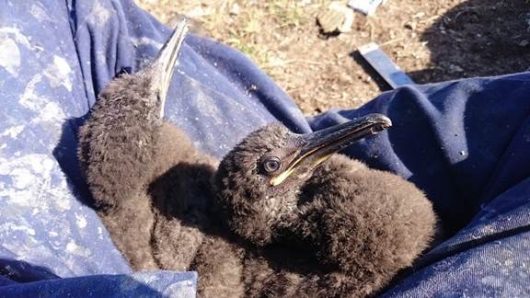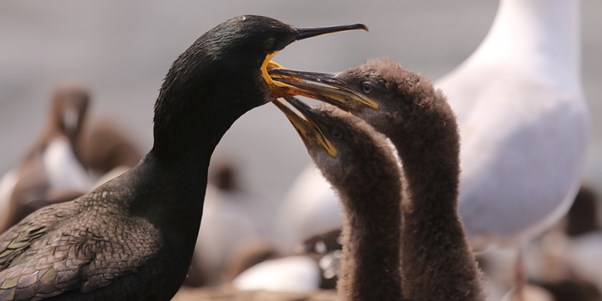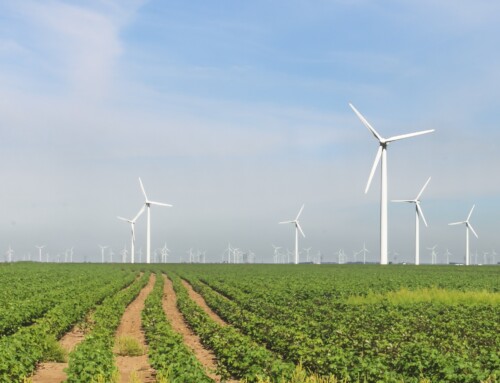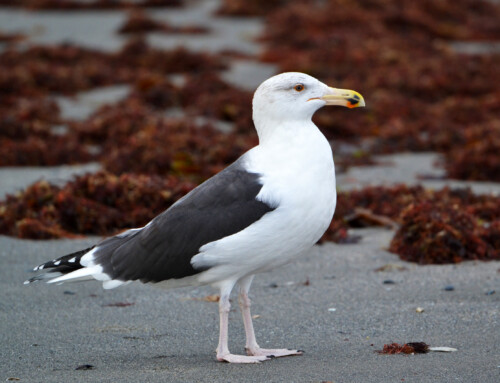Shag diet composition diversifies over 3 decades due to ocean warming
LINKED PAPER
From days to decades: short- and long-term variation in environmental conditions affect offspring diet composition of a marine top predator. Howells, R.J., Burthe, S.J., Green, J.A., Harris, M.P., Newell, M.A., Butler, A., Johns, D.G., Carnell, E.J., Wanless, S., & Daunt, F. 2017. Marine Ecology Progress Series. DOI: https://doi.org/10.3354/meps12343. VIEW
As an ecologist, there can be no doubt that the earth’s climate is changing rapidly, with profound impacts observed in many ecosystems across the globe (Walther et al. 2002; Parmesan 2006). Such effects may be short-term and direct, including increased mortality associated with extreme weather events (Moreno & Moller 2011). Alternatively, effects may occur over long periods of time and be indirect, such as bottom-up impacts of warming temperatures on lower trophic levels (Visser & Both 2005; Durant et al. 2005). Alarmingly, both these impacts are predicted to fluctuate in the future and may have important consequences for many species (IPCC 2014), yet studies tend to focus on just one. So how do individuals respond to these short- and long-term effects operating at the same time?
The North Sea is one of the most rapidly warming marine systems in the world (Høyer & Karagali 2016). During breeding, many seabirds in the North Sea depend upon the highly abundant and energy rich Lesser Sandeel, Ammodytes marinus, to feed their chicks (Furness & Tasker 2000). However, due to long-term ocean warming, the availability and quality of this important foodstuff has diminished (Arnott & Ruxton 2002; van Deurs et al. 2009). As such, several seabird populations in the UK have undergone massive declines, believed to be at least in part due to changes in this important prey (JNCC 2016). One such species is the European shag, Phalacrocorax aristotelis, which was considered a sandeel specialist in some locations, and has declined by a third in the UK between 2000 and 2015; but has their diet changed too?

Shags are black, cormorant-like seabirds that feed predominantly on fish. Unusually for seabirds, shags and other cormorants are not waterproof (Grémillet et al. 2005). This makes them vulnerable to poor weather, when they struggle to forage and large numbers can be found dead in shag “wrecks” (Frederiksen et al. 2008; Lewis et al. 2015). Therefore, shags provide a useful system in which to test the impacts of both long- and short-term climatic effects, which may alter both the availability of their prey and their foraging ability.
The UK is a great place to see shags, as they breed in internationally important numbers on rocky islands around our shores (Mitchell et al. 2004). One of the biggest and best-studied colonies is the Isle of May, Scotland, and is the focus of our study.
During the summer months, when shags build their nests on land and rear their young, researchers from the Centre for Ecology & Hydrology live alongside these birds on the island. As part of the Isle of May Long Term Study the researchers locate each shag nest, monitor its contents and ring the chicks with unique colour rings (Fig. 1; if you see a colour ringed shag please send your record to shags@ceh.ac.uk). Occasionally, if we are lucky, some birds regurgitate their last meal during chick handling (Fig. 2). This gives us all the data we need to find out what they are eating.
Using this method, we amassed 863 diet samples, collected over three decades (1985 – 2014). By combining these with environmental data collected over the same period (Sea Surface Temperature, weather conditions and plankton abundance) we tested the following aims:
- Has the diet of this population changed over the past three decades?
- What determines diet composition in this population?

We identified dramatic changes in shag diet since the 1980s (Fig. 3), driven by a range of different factors that determine which fish they eat. The proportion of sandeels declined by 48% between 1985 and 2014. Over the same period, the number of other fish prey in the diet increased, from an average of just 1 species per year in 1985 to 11 in 2014. The length of sandeel also declined from 105mm in 1989 to 92mm in 2014.

Shags in this population have changed from a diet dominated by sandeel in the 1980s, to a range of different prey in recent years, including rock butterfish, dragonets and codfishes (Fig. 4). One of the most important factors driving this change was ocean warming, in particular, Sea Surface Temperature in the previous year. When Sea Surface Temperature in the previous year was warm, shags increased the number of prey types eaten during breeding. Whether this is due to negative impacts of temperature on sandeel populations or increases in alternative prey types is difficult to determine, but accords well with previous research on the effects of ocean warming on North Sea fish (Perry et al. 2005; Dulvy et al. 2008; Hiddink & ter Hofstede 2008).

The amount of sandeel in the diet was affected by wind conditions, with fewer sandeel consumed on windy days. Although we cannot be sure of the mechanisms, wind has previously been shown to affect the foraging ability of shags; with birds reducing the time spent feeding in windy conditions (Daunt et al. 2014; Lewis et al. 2015). This may alter the ability of shags to find and capture sandeels in poor weather. Alternatively, sandeels themselves may be less active under such conditions, reducing their contribution to the diet.
Another novel finding is that the age of sandeel fed on by shags changes throughout the year, with the larger, adult sandeel the main prey before July, with the smaller, young-of-the-year sandeels consumed thereafter. This seasonal pattern has been observed in other seabird populations in the region, such as kittiwakes (Lewis et al. 2001), but is previously unreported in shags.
In summary, our research identified dramatic dietary diversification in this shag population, driven by climate-mediated ocean warming, and may have important implications for the reproductive success of this population, due to the differences in diet quality between prey types (Hislop et al. 1991). Our research also highlights that shags may be able to adapt to changing environmental conditions by exploiting new prey types, which is a luxury other seabirds in the region may not be able to afford.

References
Arnott, S.A. & Ruxton, G.D. 2002. Sandeel recruitment in the North Sea: Demographic, climatic and trophic effects. Marine Ecology Progress Series 238: 199–210. VIEW
Daunt, F. Reed, T.E., Newell, M., Burthe, S., Phillips, R.A., Lewis, S. & Wanless, S. 2014. Longitudinal bio-logging reveals interplay between extrinsic and intrinsic carry-over effects in a long-lived vertebrate. Ecology 95(8): 2077–2083. VIEW
van Deurs, M., van Hal, R., Tomczak, M.T., Jónasdóttir, S.H. & Dolmer, P. 2009. Recruitment of lesser sandeel Ammodytes marinus in relation to density dependence and zooplankton composition. Marine Ecology Progress Series 381: 249–258. VIEW
Dulvy, N.K., Rogers, S.I., Jennings, S., Stelzenmüller, V., Dye, S.R. & Skjoldal, H.R. 2008. Climate change and deepening of the North Sea fish assemblage: A biotic indicator of warming seas. Journal of Applied Ecology 45: 1029–1039. VIEW
Durant, J.M., Hjermann, D.Ø, Anker-Nilssen, T., Beaugrand, G., Mysterud, A. Pettorelli, N. & Stenseth, N.Chr. 2005. Timing and abundance as key mechanisms affecting trophic interactions in variable environments. Ecology Letters 8(9): 952–958. VIEW
Frederiksen, M., Daunt, F., Harris, M.P. & Wanless, S. 2008. The demographic impact of extreme events: Stochastic weather drives survival and population dynamics in a long-lived seabird. Journal of Animal Ecology 77(5): 1020–1029. VIEW
Furness, R.W. & Tasker, M.L. 2000. Seabird-fishery interactions: Quantifying the sensitivity of seabirds to reductions in sandeel abundance, and identification of key areas for sensitive seabirds in the North Sea. Marine Ecology Progress Series 202: 253–264. VIEW
Grémillet, D., Chauvin, C., Wilson, R.P.,Le Maho, Y. & Wanless, S. 2005. Unusual feather structure allows partial plumage wettability in diving great cormorants Phalacrocorax carbo. Journal of Avian Biology 36: 57–63. VIEW
Hiddink, J.G. & ter Hofstede, R. 2008. Climate induced increases in species richness of marine fishes. Global Change Biology 14(3): 453–460. VIEW
Hislop, J.R.G., Harris, M.P. & Smith, J.G.M. 1991. Variation in the calorific value and total energy content of the lesser sandeel (Ammodytes marinus) and other fish preyed on by seabirds. Journal of Zoology 224(3): 501–517. VIEW
Høyer, J.L. & Karagali, I. 2016. Sea Surface Temperature climate data record for the North Sea and Baltic Sea. Journal of Climate 29(7): 2529–2541. VIEW
IPCC. 2014. Climate change 2014: Synthesis report. Contribution of working groups I, II and III to the fifth assessment report of the Intergovernmental Panel on Climate Change. Core Writing Team, R. Pachauri, & L. Meyer, eds., Geneva, Switzerland. VIEW
JNCC. 2016. Seabird population trends and causes of change: 1986-2015 report. VIEW
Lewis, S., Phillips, R.A., Burthe, S.J., Wanless, S. & Daunt, F. 2015. Contrasting responses of male and female foraging effort to year-round wind conditions. Journal of Animal Ecology 84: 1490–1496. VIEW
Lewis, S., Wanless, S., Wright, P.J., Harris, M.P., Bull, J. & Elston, D.A. 2001. Diet and breeding performance of black-legged kittiwakes Rissa tridactyla at a North Sea colony. Marine Ecology Progress Series 221: 277–284. VIEW
Mitchell, P.I., Newton, S.F., Ratcliffe, N. & Dunn, T.E. 2004. Seabird populations of Britain and Ireland. Poyser, London: T and A.D. VIEW
Moreno, J. & Moller, A.P. 2011. Extreme climatic events in relation to global change and their impact on life histories. Current Zoology 57(3): 375–389. VIEW
Parmesan, C. 2006. Ecological and evolutionary responses to recent climate change. Anuul Review of Ecology Evolution and Systematics 37(May): pp.637–669. VIEW
Perry, A., Low, P.J., Ellis, J.R. & Reynolds, J.D. 2005. Climate change and distribution shifts in marine fishes. Science 308: 1912–1915. VIEW
Visser, M.E. & Both, C. 2005. Shifts in phenology due to global climate change: the need for a yardstick. Proceedings of the Royal Society B: Biological Sciences 272(1581): 2561–2569. VIEW
Walther, G.-R., Post, E., Convey, P. Menzel, A., Parmesan, C., Beebee, T.J.C., Fromentin, J.-M., Hoegh-Guldberg, P. & Bairlein, F. 2002. Ecological responses to recent climate change. Nature 416: 389–395. VIEW
Image credit
Featured image: A European Shag, Phalacrocorax aristotelis, feeding young © Ann Chapman
If you want to write about your research in #theBOUblog, then please see here.





